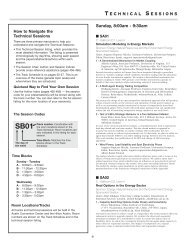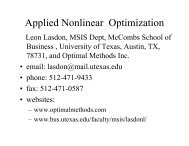Sunday
Sunday
Sunday
You also want an ePaper? Increase the reach of your titles
YUMPU automatically turns print PDFs into web optimized ePapers that Google loves.
SB13<br />
4 - Lower-bound Analyses of the Lift-and-Project Ranks of<br />
Graph-based Polytopes<br />
Yu Hin Au, PhD Candidate, University of Waterloo, 200 University<br />
Ave., W., Waterloo, ON, N2L3G1, Canada, yau@uwaterloo.ca<br />
We’ll discuss some ongoing work on obtaining inapproximability results for<br />
Bienstock-Zuckerberg and Lasserre lift-and-project algorithms on graph-based<br />
optimization problems. This is joint work with Levent Tuncel.<br />
■ SB13<br />
13- West 106 B- CC<br />
Computational Issues on Solving Mixed Integer<br />
Second Order Cone Optimization Problems<br />
Sponsor: Optimization/Linear Programming and Complementarity<br />
Sponsored Session<br />
Chair: Julio Cesar Goez, PhD Candidate, Lehigh University, 18015,<br />
United States of America, jgoez1@gmail.com<br />
1 - Computational Effectiveness of Split Cuts for Second-order<br />
Conic Programming<br />
Sina Modaresi, University of Pittsburgh, 3700 O’Hara Street,<br />
Pittsburgh, United States of America, sim23@pitt.edu,<br />
Mustafa Kilinc, Juan Pablo Vielma<br />
Split cuts are one of the most effective cuts for linear MIPs and they are<br />
equivalent to MIR cuts. We show that this equivalency does not hold for secondorder<br />
conic MIPs by giving examples where split cuts strictly dominate conic MIR<br />
cuts proposed by Atamturk et al.. However, split cuts have to be added as<br />
nonlinear inequalities, while conic MIR cuts can be added as linear inequalities to<br />
the extended formulation. We compare the trade-off between the speed and the<br />
strength of these cuts.<br />
2 - Branch and Bound for Mixed Integer Second Order Cone<br />
Optimization: Impact of Disjunctive Conic Cuts<br />
Julio Cesar Goez, PhD. Candidate, Lehigh University, 18015,<br />
United States of America, jgoez1@gmail.com, Pietro Belotti,<br />
Ted Ralphs, Tamás Terlaky, Imre Polik<br />
We investigate the use of Disjunctive Conic Cuts (DCC) in a Branch and Cut<br />
framework when solving MISOCO problems. Various criteria are explored to<br />
select the disjunctions to build DCCs at different nodes of the tree. Additionally,<br />
we explore different criteria for node selection and branching rules. These<br />
experiments will help us to understand the impact that DCCs have in decreasing<br />
the size of the search tree and the solution time.<br />
3 - Restrict-and-Relax Search for 0-1 Integer Programs<br />
Menal Guzelsoy, SAS, 100 SAS Campus Drive, Cary, NC, 7513,<br />
United States of America, menal.guzelsoy@sas.com,<br />
George Nemhauser, Martin Savelsbergh<br />
We introduce restrict-and-relax search, an algorithm for 0-1 integer programs<br />
that explores a dynamic search tree by not only fixing variables (restricting), but<br />
by also unfixing previously fixed variables (relaxing). Starting by solving a<br />
restricted integer program, we may at any tree node selectively relax/restrict<br />
variables using dual/structural information. A proof-of-concept computational<br />
study demonstrates the effectiveness of the algorithm.<br />
4 - A Regularized Interior-Point Method for<br />
Semidefinite Programming<br />
Ahad Dehghani, McGill University, Montreal, Canada,<br />
ahad.dehghani@mcgill.ca, Jean-Louis Goffin, Dominique Orban<br />
Interior-point methods in semi-definite programming (SDP) require the solution<br />
of a sequence of linear systems which are used to derive the search directions.<br />
Safeguards are typically required in order to handle rank-deficient Jacobians and<br />
free variables. We propose a primal-dual regularization to the original SDP and<br />
show that it is possible to recover an optimal solution of the original SDP via<br />
inaccurate solves of a sequence of regularized SDPs for both the NT and dual<br />
HKM directions.<br />
INFORMS Phoenix – 2012<br />
84<br />
■ SB14<br />
14- West 106 C- CC<br />
Uncertainty in Project Management<br />
Contributed Session<br />
Chair: Bajis Dodin, Professor, University of California, School of<br />
Business Administration, Riverside, CA, 92521, United States of<br />
America, bajis.dodin@ucr.edu<br />
1 - Enumerating Feasible Task Sets with Ordered, Unmeasured<br />
Material Constraints<br />
Jordan Srour, Assistant Professor, Lebanese American University,<br />
P.O. Box 13-5053, Beirut, Lebanon, fjsrour@gmail.com,<br />
Walid Nasrallah<br />
We investigate the solution space for selecting a subset of project tasks under a<br />
resource shortage. The amount of resource required by each task is not known,<br />
but the tasks are fully ordered accordingly. We enumerate the ways to select a<br />
subset of tasks without exceeding the resource constraint. We highlight the<br />
relationship of this enumeration to published number sequences arising from<br />
regular Boolean functions. We provide both an enumeration algorithm and<br />
enumerations up to n=10.<br />
2 - Stochastic Approach for Project Scheduling Based on<br />
Fund Availability<br />
Yuvraj Gajpal, Assistant Professor, King Fahd University of<br />
Petroleum and Minerals, KFUPM Box 634, Dhahran,<br />
Saudi Arabia, gajpaly@gmail.com, Ashraf Elazouni<br />
The paper considers a finance based project where the contractors finance projects<br />
mainly through the owners’ progress payments supplemented by fund procured<br />
through establishing credit-line accounts. In this situation the best proactive<br />
approach for contractor is to schedule construction activities based on the<br />
available finance. A stochastic heuristic approach is proposed to device financebased<br />
schedules of multiple projects.<br />
3 - A Nonlinear Programming Model for Stochastic Project<br />
Crashing<br />
Ronald Davis, Associate Professor, San Jose State University,<br />
College of Business, One Washington Square, San Jose, CA,<br />
95192, United States of America, ronald.davis@sjsu.edu<br />
When beta distributions are used for every activity early start and finish time<br />
distribution in a project network, moment preserving beta approximations for the<br />
sum and product of beta cdfs can be coded in VBA to allow an analytic stochastic<br />
forward pass to be carried out, without simulation. Introduction of crashing<br />
variables and costs yields a nonlinear programming formulation to minimize<br />
crash cost subject to a constraint on mean project duration. Realistic example<br />
SOLVER results are shown.<br />
4 - Portfolio Management in a Highly Uncertain Environment: The<br />
Role of Interdependencies<br />
Olga Kokshagina, PhD Student, Centre for Scientific Management<br />
(CGS), CGS Mines ParisTech, 60 Boulevard Saint-Michel, Paris,<br />
75272, France, olga.kokshagina@mines-paristech.fr, Patrick Cogez,<br />
Pascal Le Masson, Benoit Weil<br />
This work deals with portfolio management strategies in high uncertainty. There<br />
exist strategies that consider projects separately or dependently. Literature shows<br />
first, the dependencies have a tendency to increase complexity and cost of the<br />
system. Second, there is a possibility to share risks in between projects, to<br />
highlight the effect of learning. Our paper investigates the contradictory role of<br />
interdependencies and the relevant management strategies in particular industrial<br />
situations.<br />
5 - Scheduling & Financial Planning in Probabilistic Projects<br />
Bajis Dodin, Professor, University of California, School of Business<br />
Administration, Riverside, CA, 92521, United States of America,<br />
bajis.dodin@ucr.edu, Abdelghani Elimam<br />
In probabilistic projects (PP) required duration and resources for some or all<br />
activities are given as random variables characterized by their own probability<br />
distribution functions (PDFs). Managing a PP requires dealing with several<br />
important issues. In this paper, we analyze the impact of the various stochastic<br />
variations on the duration, and cost of the project. Procedures for determining the<br />
PDFs of project cost and duration, and project schedule are developed.



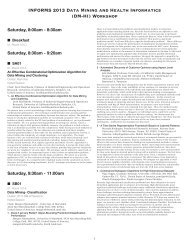
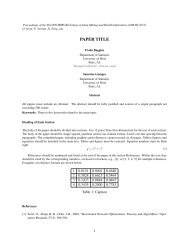
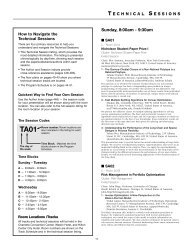
![[PDF] Charlotte Back Matter](https://img.yumpu.com/17933057/1/190x245/pdf-charlotte-back-matter.jpg?quality=85)

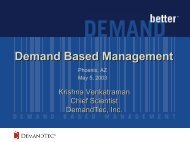
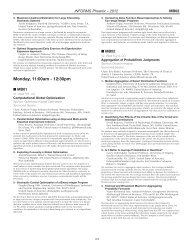
![[PDF] ALIO Back Matter](https://img.yumpu.com/17932960/1/190x245/pdf-alio-back-matter.jpg?quality=85)
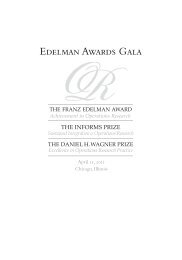
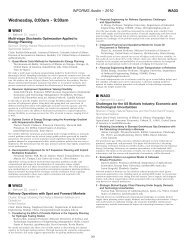
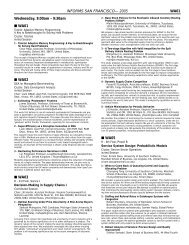
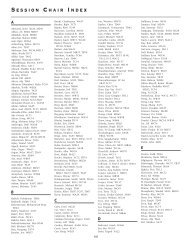
![[PDF] Monday, 8:00am - 9:30am](https://img.yumpu.com/17932954/1/190x245/pdf-monday-800am-930am.jpg?quality=85)
